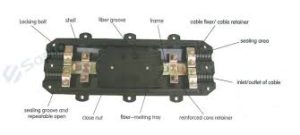Fiber Optic Joint Closure Ensure Signal Integrity
Fiber optic communication networks offer impressive connectivity, but they are exposed to some of the harshest environments on the planet. How do these hair-thin cables and their spliced connections survive these hostile conditions? This is where a fiber optic joint closure comes in.
Generally known as fiber splice closure, it is an electrically insulated and watertight box that provides space for splicing optical fibers together. It also protects the spliced joints from environmental elements and ensures signal integrity. The splice closure has excellent mechanical strength, and its strong outer shell can withstand even the most extreme weather.

There are many different types of Fiber optic joint closure on the market, and it is important to choose the right one for your network. You need to take into consideration the size, type, and configuration of your cables. You should also look at the number of splice ports, as well as their capacity. The more splice ports a splice closure has, the higher its capacity.
How Does a Fiber Optic Joint Closure Ensure Signal Integrity?
You also need to consider how often you will need to access the splice closure. Closures near the distribution point typically don’t require regular accessibility, while those at the drop lines will need frequent re-entry. This is why it is important to choose a splice closure that allows you to easily access the spliced cables when necessary.
A splice closure can be a very useful tool for network planners and engineers, as it can help them manage their cables better. It can also help them identify issues that could be affecting performance, and can prevent downtime due to cable damage. In addition, a good splice closure can also protect the connection from interference and electromagnetic fields.
When choosing a fiber optic splice closure, you should keep in mind the types of cables that will be installed in your network. This is because some splice closures have a limited capacity, especially when they are not used correctly. For instance, if the cables are not fusion-spliced properly, they may reduce the capacity of the splice tray in the closure. The same is true for ribbon or mechanical splices. Therefore, it is important to use only fusion-spliced cables in your fiber optic splice closure.
A fiber optic joint closure plays a crucial role in maintaining signal integrity in optical communication networks. This protective enclosure safeguards the delicate optical fibers against environmental factors such as moisture, dust, and physical stress. By creating a sealed environment, it prevents signal degradation and loss that could occur due to exposure. Additionally, the closure aligns and protects fiber connections, ensuring minimal signal attenuation and reflection. This technology is essential for sustaining reliable and high-quality data transmission over long distances. In essence, a fiber optic joint closure acts as a shield, preserving the integrity of signals and enhancing the overall performance of optical networks.
Besides the size, type, and capacity of your cables, you should also consider the entrance capability of the splice closure. This is because the amount of cables that can be spliced in a splice closure depends on the number and size of ports on its body. A splice closure with more ports can hold more cables, so it is important to check the capacity before you make your purchase.
The splice closure should be durable and easy to install. It should also be compatible with the cables in your network. This will help you avoid unnecessary expenses and ensure that your network is running efficiently. To avoid future problems, it is recommended to buy a splice closure that can handle future growth. For instance, a modular splice closure can be expanded to accommodate new cable connections.